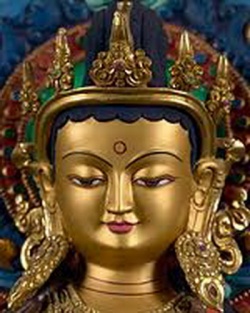Fa-hsiang
A school of Chinese Buddhism that teaches that all of reality is an evolution of a fundamental level of consciousness. Because of this, it is often refered to as the wei-shih, or ‘consciousness-only’ (Sanskrit, vijñapti-mātra) school. This school derives from pre-existing streams of Indian Mahāyāna thought based on the writings of Asaṇga and Vasubandhu which crystallized into the Indian Yogācāra (also known as the Vijñānavāda) school. This school taught that there are within each individual's mind eight levels of consciousness: the five senses, the mind that gathers and processes their sensory data, a seventh mind that is the centre of analytical thought called manas, and finally, an eighth level called the ālaya-vijñāna or ‘storehouse consciousness’. This last contains all of the ‘seeds’ implanted by karmic acts which will in the future give rise to all perceptions and actions when conditions for them become right. In unenlightened beings, these seeds come to maturity as mistaken perceptions of reality, and give rise to its artificial division into ‘self’ and ‘other’, obscuring the realization that all things are equally projections of the ālaya-vijñāna. Enlightenment (bodhi) comes about when beings realize that all things are merely evolutions of the ālaya-vijñāna, that is, are ‘consciousness-only’, thus eradicating any remaining notion of a separation of self and other, or that phenomena enjoy any kind of independent existence.
Another feature of Fa-hsiang thought was the analysis of the world into three levels of perception and existence, called the ‘three natures’ (san hsing). The first, representing objects of perception, was called the ‘other-powered nature’ (Sanskrit, paratantra- svabhāva; Chin., ta ch'i hsing) since they arose only in dependence upon causes and conditions external to themselves. The second was the ‘imaginary nature’ (Sanskrit, parikalpita-svabhāva; Chin., suo chih hsing), and represented things as mistakenly perceived by the unenlightened, that is, as independently existing things that are separate and distinct from the consciousness that perceives them. The third was called the ‘consummate nature’ (Sanskrit, pariniṣpanna-svabhāva; Chin., ch'eng shih hsing), and represented things perceived correctly by an enlightened consciousness, that is, as evolutions of that consciousness with no distinction between subject and object. An aspect of this school's teaching that was to have decisive consequence for its fortunes in China was the idea that there were certain beings, called icchantikas, who lacked any seeds of Buddhahood in their makeup, and thus would never attain this goal.
The school in China traces its origin to the Indian monk-translator Paramārtha (499-569), who arrived in China in 546. Among the many texts that he brought and translated, he was best known for his teaching of Asaṇga's Mahāyāna-saṃgraha (Compendium of the Mahāyāna). Known in China by its short title She-lun, it became the basis for the She-lun school that studied it intensively. Later, the great Chinese pilgrim and translator Hsüan-tsang (596-664) brought back and translated many more Indian Yogācāra texts, and a new school consolidated around him, superseding the older She-lun school. However, the teaching of icchantikas did not suit the atmosphere of Chinese Buddhism, which took universal salvation as an object of faith, and so the school did not survive past the first generation of Hsüan-tsang's disciples, the best-known of whom was K'uei-chi (632-82). The system of doctrinal classification put forward by the Hua-yen school shortly thereafter placed Fa-hsiang at the level of ‘elementary Mahāyāna’, just one step above Hīnayāna.
Interestingly, when Buddhism experienced a revival of interest among intellectual circles in the late 19th and early 20th centuries, Fa-hsiang studies came to the forefront once again. The revivers saw in Fa-hsiang thought the best chance for harmonizing traditional Buddhist philosophy with the modern scientific viewpoint. See also Hossō; wei-shih.
